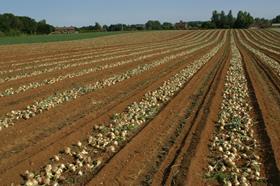
Despite numerous challenges and unpredictable weather patterns, the UK onion industry remains resilient and adaptable.
Before looking ahead to the 2016 UK onion season, it is worth considering the 2015 crop and the quality in store. Marketed up until early July 2016, there is typically a very short import window of around two to three weeks before new season British onions return to the supermarket shelves.
According to Sam Rix, technical director of PG Rix (Farms) and chairman of the British Onions R&D committee, the quality of the 2015 crop in store has been mixed. “This is due largely to the cold slow spring last year, the dull, cool August, which delayed crop maturity and then the wet September − the main period of onion harvest. However, continuing investment in machinery and storage is helping to negate the impact of our unpredictable UK weather on final cropquality.”
He goes on to say that waste levels have been higher than average at around eight per cent, compared to the 10-year average of 6.5 per cent. “The main problem has been Fusarium at an average infection level of three per cent across all store samples. Problems were compounded by a warm December and January, making cooling crops, particularly in ambient stores, challenging. UK stocks are tight but considered to be in balance to supply until end of June/early July.”
With the later-harvested and poorest-quality crop now largely sold, Rix believes there is sufficient crop of the quality demanded by the market, a situation that seems to be echoed across northern Europe.
Turning to the 2016 crop, the estimated 300ha of overwintered onion crop established well in the favourable 2015 autumn conditions. However, milder than average winter conditions have led to continual growth and bolting risk is assessed as being high.
“Overwintered crops established well but with warm ambient conditions and long hours of leaf wetness in November infections of Downy Mildew appeared, as never seen before,” says grower Jason Thurlow of G’s Fresh. “Nevertheless a few sharp frosts controlled it. Here in East Anglia we experienced delays in the drilling and planting of overwintered sets, meaning our bolting risk is modest while harvest is on schedule for end of June.
“As of early March the set crops have established well and are now emerging – their potential looks good. With the high cost of early hybrid varieties, and suppressed sales values, it is questionable whether the industry can justify their use. In contrast, the area and demand for early production in central Europe is growing yearly, as early ware crop premiums still exist.
“Overall our area of drilled crop this year is slightly lower than 2015 – but tonnage should remain similar. We are only producing on productive land as there is no room for average performance fields.”
Meanwhile across the UK onion production areas, the area of reds continues to increase year on year and is now estimated to account for 26 per cent of total production. In terms of the challenges ahead, Thurlow says productivity is driven by the availability of fertile, clean land. “The industry’s key challenge is to farm sustainably using the land resource available, but with a reducing range of pesticides, increasing field issues i.e soil-borne diseases and pernicious weeds, and milder winters while returns fall.”
As with all field vegetable sectors, the loss of plant protection products continues to have a major impact on UK onion crop agronomy and the economic viability of production. Ioxynil (Totril) has a final use-up date of 31 August 2016. “This contact herbicide is the main product used in the weed control programme,” says Rix. “Its loss will cause major headaches for growers and agronomists. Meanwhile Tepraloxydim products, such as Aramo, have a final use-up date of 30 November 2016. This loss will leave the industry without adequate control of annual meadow and black grass. In response, we are working closely with AHDB to gain approval of Clethodim (Centurion Max) in time for the 2017 season.”
In recent years Fusarium oxysporum f.sp. cepae levels have substantially increased. This fungal pathogen causes base rot in onions and even whole field crop loss. While breeding for Fusarium and Downy Mildew resistance continues for new cultivars, AHDB Horticulture is set to launch an ambitious five-year cross-sector project researching the biology and control of Fusarium diseases across multiple crops, including onions.
According to British Onions’ outgoing chairman Chris Wilkinson: “With a depleting armoury of chemical options there is little doubt the industry will have to adapt and better use a combination of cultural techniques and engineering solutions to ensure adequate levels of weed control in the future.
“Meanwhile a range of cross-sector projects are looking at specialist machinery, soil health and amendments while independent consultants, such as VCS, are making headway developing system efficiencies and sustainable strategies. As an industry we are taking steps now to future-proof UK onion production to ensure it remains viable and competitive for the next generation.”



